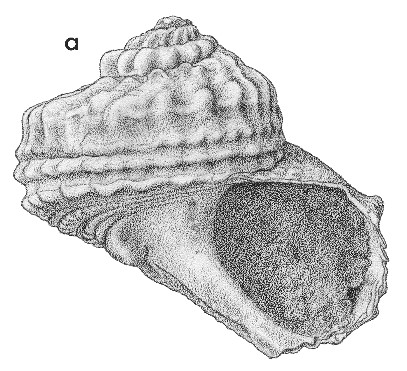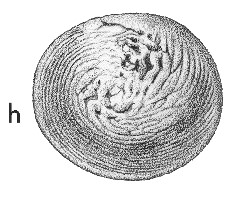
Revised descriptions of New Zealand Cenozoic Mollusca from Beu and Maxwell (1990)

 | Revised descriptions of New Zealand Cenozoic Mollusca from Beu and Maxwell (1990) | 
|
  (Pl. 14a): GS3600, F46/f8492, Mataura River, near Brydone, Southland, Waitakian (GNS) |
  (Pl. 14h): GS3600, F46/f8492, Mataura River, near Brydone, Southland, Waitakian (GNS) (operculum). |
Beu & Maxwell (1990): Chapter 10; p. 155; pl. 14 a, h.
Classification: Turbinidae
Description: Large for family (height 80-90 mm), turbiniform, spire somewhat less than half total height. Protoconch depressed, very small, of slightly more than 1 whorl. Teleoconch of about 7 whorls, apex flat with a sharp, serrate peripheral keel that descends and becomes more rounded during growth, situated at, or somewhat above mid-whorl on later whorls; sutural ramp convex, sides subvertical. Last whorl with peribasal angulation and a peripheral keel between it and upper angulation; base slightly convex with a strongly projecting keel bordering inner hp callus. Axial sculpture of short, rounded, strongly opisthocline, non-collabral ridges bordering upper suture, extending at least halfway across ramp on early whorls, but gradually shortening to become rounded nodules or becoming obsolete on later whorls; serrations on shoulder angle changing into prominent rounded nodules during growth, becoming almost obsolete on last whorl of some shells. Spiral sculpture on ramp of numerous very fine threads, some shells with obscure coarser elements as well; a prominent cord appearing out of suture on penultimate whorl to become peripheral keel, accompanied by a weaker one above, and one of similar strength below, forming a peribasal keel; base with 4 somewhat narrower cords; all cords nodulose, the peripheral and peribasal cords most prominently. Aperture markedly prosocline, inner lip with prominent callus band. Operculum oval, central area of outer surface irregularly sculptured, remainder with deeply incised grooves.
Comparison: The new species differs from Sarmaturbo superbus (Otaian, Auckland), the type species of Sarmaturbo Powell, 1938, primarily in having more numerous and smaller nodules, particularly on the shoulder angulation. S. colini (Tongaporutuan, Hurupi Stream, Palliser Bay) also has sparse but large nodules on the shoulder angulation, and further differs from the Brydone species in its less prominent spiral sculpture and in having large nodules on the keel bordering the inner lip callus.
Sarmaturbo resembles Sarmaticus Gray, 1847 (type species S. sarmaticus (Linne, 1758); Recent, South Africa) in overall shell characters, but differs in its distinctive operculum, which is grooved rather than papillose. The genus, which includes some of the largest of all New Zealand gastropods, has a recorded range of Waitakian to Tongaporutuan, and besides the species discussed here includes undescribed species from the shellbed at the junction of Porter and Thomas Rivers, Castle Hill Basin (Altonian) and from Haungakakahu Stream, East Cape (? Southland Series). All records of Sarmaturbo indicate a shallow-water, firm-bottom habitat.
Distribution: Waitakian, Chatton Formation, Mataura River, near Brydone, Southland (not uncommon).
Cite this publication as: "A.G. Beu and J.I. Raine (2009). Revised
descriptions of New Zealand Cenozoic Mollusca from Beu and Maxwell (1990). GNS
Science miscellaneous series no. 27."
© GNS Science, 2009
ISBN
978-0-478-19705-1
ISSN 1177-2441
(Included with a PDF facsimile file
copy of New Zealand Geological Survey Paleontological Bulletin 58 in CD version
from: Publications Officer, GNS Science, P.O. Box 30368 Lower Hutt, New
Zealand)